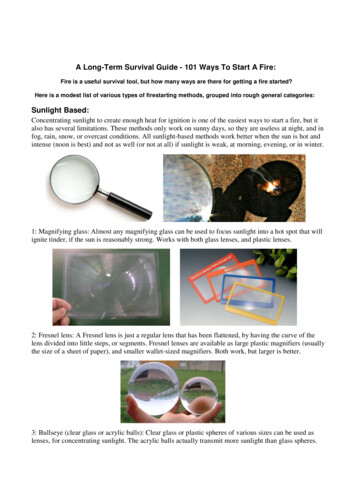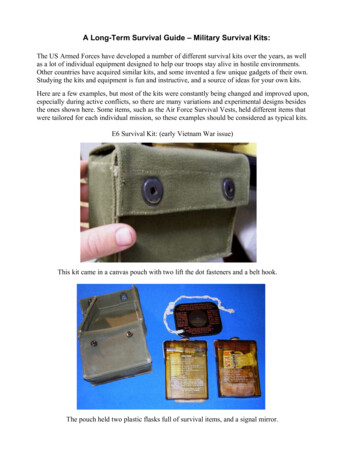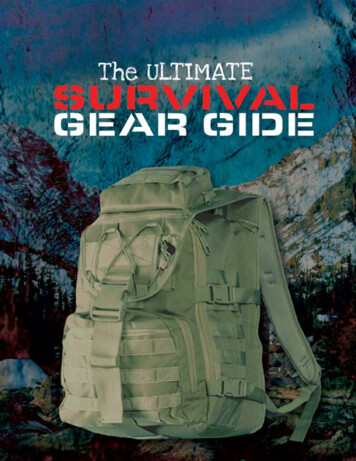
Transcription
A Long-Term Survival Guide - 101 Ways To Start A Fire:Fire is a useful survival tool, but how many ways are there for getting a fire started?Here is a modest list of various types of firestarting methods, grouped into rough general categories:Sunlight Based:Concentrating sunlight to create enough heat for ignition is one of the easiest ways to start a fire, but italso has several limitations. These methods only work on sunny days, so they are useless at night, and infog, rain, snow, or overcast conditions. All sunlight-based methods work better when the sun is hot andintense (noon is best) and not as well (or not at all) if sunlight is weak, at morning, evening, or in winter.1: Magnifying glass: Almost any magnifying glass can be used to focus sunlight into a hot spot that willignite tinder, if the sun is reasonably strong. Works with both glass lenses, and plastic lenses.2: Fresnel lens: A Fresnel lens is just a regular lens that has been flattened, by having the curve of thelens divided into little steps, or segments. Fresnel lenses are available as large plastic magnifiers (usuallythe size of a sheet of paper), and smaller wallet-sized magnifiers. Both work, but larger is better.3: Bullseye (clear glass or acrylic balls): Clear glass or plastic spheres of various sizes can be used aslenses, for concentrating sunlight. The acrylic balls actually transmit more sunlight than glass spheres.
4: Improvised lens (glasses): It is possible to use glasses to start a fire, but not as easy as you mightthink. Reading glasses are often simple magnifying lenses, and work ok if the magnification is highenough, but most prescription glasses nowadays have specific shapes that do not work as well. Even so,you can often get success if you carefully bead a blob of clear water onto the top of the lens, to make amore effective lens shape (hold the glasses still, to avoid spilling the water, and move the tinder bundle,not the glasses, to find the best focal spot).5: Improvised lens (binoculars): Many optical devices contain lenses, which can be removed for use assunlight-based firestarters. Some work just fine as is, without needing to take them apart. Binoculars canbe used to start fires, by pointing the large end at the sun, and then finding the focal spot at the small end(this is why it is a very bad idea to look at the sun through binoculars!). Items 6, 7, 8, & 9 work the sameway. With variable-power optics, higher magnification settings usually work better than lower settings.6: Improvised lens (monocular)7: Improvised lens (telescope or spotting scope)8: Improvised lens (rifle scope)9: Improvised lens (camera lens)
10: Improvised lens (clear ice): It is possible to make a serviceable lens from clear ice, and use it to starta fire, under good conditions. The ice must be clear, and clear ice is usually only found alongsiderunning streams. You can also boil water to remove the air, then freeze it to get clear ice to practicewith. An ice lens must be fairly large to work, as big as your hand or larger, and the edges must have afairly severe bevel, so it must also be three or four inches thick.11: Improvised lens (clear bottle and clear water): A clear plastic bottle can work as a lens, but only ifthe top is curved like the example shown, and only if it is filled with clear water.12: Improvised lens (clear balloon): A clear balloon can be filled with enough clear water to make aspherical lens, and it will work, but clear balloons are not a very common item.
13: Improvised lens (clear plastic bag): A clear plastic bag can be used as an improvised lens by addingclear water and twisting part of the bag into a sphere shape. It needs to be three or four inches across, towork well. Items 14 and 15 can be used in the same way.14: Improvised lens (clear condom)15: Improvised lens (clear plastic wrap, Cling wrap or Saran wrap, or clear plastic from a garment bag)16: Improvised lens (clear light bulbs and water): Clear light bulbs will also work as improvised lenses,for sunlight-based fire starting, if the elements are removed and the glass bulb is filled with clear water.17: Improvised lens (clear wine glass and water): The right size and shape of wine glass can be usedwith clear water, to form a lens. Hold the glass tilted at an angle as shown, to get a useable lens shape.
18: Parabolic reflector (solar cigarette lighter): You can buy a small parabolic reflector, called a solarcigarette lighter, which will concentrate enough sunlight onto its focal spot to ignite any good tinder.19: Improvised parabolic reflector (satellite dish and foil): Any satellite dish can be used as a largerparabolic reflector, by covering the inner curved surface with foil, and then aiming it towards the sun.But be careful when finding the focal spot, as larger reflectors can create enough heat to be dangerous.20: Improvised parabolic reflector (stainless kitchen bowl, or bowl and foil): Some bowls are the rightshape to use as improvised parabolic reflectors. Stainless steel bowls may be reflective enough to work,but any bowl can be lined with foil, and then tested. Small reflectors don’t work if your fingers block thesunlight, so the best way to use them is to impale (or wind) your tinder on a thin stick, or a piece of wire.
21: Improvised parabolic reflector (aluminum beverage can bottom and polish): The bottom of analuminum beverage can is just large enough to work as an improvised parabolic reflector under idealcircumstances, if the surface is made more reflective by using an improvised metal polish. (Chocolateand toothpaste have both been successfully used to polish can bottoms.) Use with “tinder on a stick”.Note that it may take a long time to get the can bottom polished enough to work, so don’t expect to beable to try this after just a few minutes of effort.22: Improvised Parabolic Reflector (soup ladle): Some large stainless steel soup ladles can work asparabolic reflectors under good conditions, if they are polished enough, and the shape is correct.23: Improvised Parabolic Reflector (flashlight reflector): If you have a large flashlight, it might bepossible to remove the reflector and use it as a parabolic fire starter. One advantage to these is that thetinder can be inserted through the hole in the center that was originally used for the flashlight bulb.
Spark Based:Creating a spark (which is captured in tinder and nursed into a flame) is an old fire-starting techniquethat has a number of modern variations, but all of them require specific materials to be successful.24: Flint and Steel (with char-cloth): Traditional flint and steel fire-starting requires a hardened piece ofhigh-carbon steel (an old file works well), a piece of flint with a sharp broken edge, and a very goodtinder for catching the spark (char-cloth, or charred cotton cloth, was the traditional tinder of choice).When the fire steel is swept past the flint, striking the edge on the way past, the extremely hard flinttears bits of the very hard steel off, and these tiny bits are heated to a molten state in the process. Sparksfrom a good fire steel actually make a small crackling, hissing noise as they are produced.(Other stones, such as granite, quartz, and chert, can also make a good spark with a high-carbon steel.)Char-cloth is made by putting pieces of cotton cloth (t-shirt material works very well) in a small metalcan with a lid, making a small hole in the lid, and cooking the can on campfire coals until the cloth ischarred. (Flammable gasses will escape from the hole.) The charred cloth is kept as dry as possible.When a fire is needed, a small piece of the cloth is placed on the edge of the flint, as shown above, tocatch the sparks from the strike. The lit cloth is then folded around the spark, and blown on gently tomake the spark spread.The cloth is placed into a tinder bundle, and blown into a flame, but good char-cloth often bursts intoflame by itself, without needing to use the tinder bundle.There are other ways to make char-cloth, such as putting the cloth into a pair of clamshells that are thencoated with clay and baked on coals (leaving a tiny hole for the volatile gasses to escape).And if you don’t have any cloth, you can char other materials, such as cattail fluff, and tinder fungus.
25: Flint Stick Fire-Starters: Flint sticks are just oversized versions of the little flints found in everycigarette lighter. They are scraped with a knife blade, or other sharp object, and create very hot sparksthat will light most good tinder materials. There are several brands of flint stick, but they all work thesame way.26: Plastic Match Safes: Even if you have used all of the matches that were in your plastic match safe,you may still be able to start a fire with the safe itself, because some of them have a small flint stick onthe bottom. The orange match safe currently sold at WalMart (for about one dollar) has the flint stick.27: Magnesium Firestarters: This is just a flint stick glued to a small block of magnesium, which can bescraped to create a pile of hot-burning magnesium shavings, and then the shavings are lit with the flint.
28: Blast Match: A Blast Match is a flint stick with a built-in scraper, so it can be used with one hand.The flint is held above some tinder, then you press on the scraper and push down, to make the sparks.29: Permanent Match: A permanent match has a flint stick on the side of a small container that holdssome lighter fluid, and a scraper with a wick on the end, which normally stores in the container. To use,the scraper is removed from the container and used to make sparks on the flint stick, to light the wick.Like a zippo lighter, the permanent match must be refilled with lighter fluid every so often to work.30: Spark Lite (zippo emergency firestarter): This firestarter uses a flint and striker wheel, very similarto a regular cigarette lighter. There are several firestarter sticks stored inside this unit, and you removeone of the firestarter sticks, and use the flint-wheel to make sparks to light the stick. Firestarter sticksmust be replaced as they are used up, but this fire-starting device does not require any lighter fluid.
Friction Based:You actually can start a fire by “rubbing two sticks together” (well technically, you create a coal that canbe placed into tinder, and nursed into a flame). There are several different friction fire-starting methods,with variations for each, but most use a spinning stick on a stationary stick, creating tiny bits of hotwood dust, that build up until they form a small glowing ember.31: Hand Drill: A straight spindle stick is spun between the palms, while resting in a prepareddepression (the spindle hole) on a stationary hearthboard, until a coal is produced. A notch is usually cutinto the side of the hearthboard, deep enough to reach the spindle hole, so that the hot wood dust can fallinto this notch and build up in one spot. This technique requires practice, and good materials, to work.Experienced people use a spindle that is about the thickness of a pencil – thicker ones are harder to spin.32: Team Hand Drill: Two people can work together to keep a hand drill spinning, to reduce fatigue.
33: Thong Hand Drill: Tying a cord (with thumb loops) to the top of the spindle of a hand drill allowsyou to increase downward pressure as you spin the spindle, and your hands don’t travel down as youspin, making this a much easier technique to use.34: Shoe Hand Drill: Spinning the hand drill can cause your palms to ache. One way to avoid this is tohold a pair of shoes against the spindle, so that the soles absorb all the punishment. Use a cord withthumb loops as well (try the shoelaces). Other objects could also be used, if you don’t have shoes, suchas short lengths of 2x4 lumber (roughen the contact surfaces), or pads cut from an automobile tire.
35: Collapsible Hand Drills: The spindle of your hand drill can be made from two or more pieces, with asocket made from bamboo (or metal tubing). This design lets you carry the spindle as a shorter package,and it is easier to find short straight pieces and combine them, than it is to find one long straight piece.(You can straighten curved sticks to make straight spindles, but you need a fire first, to heat them with.)36: Miniature Hand Drill: Another variation on hand drills is the miniature hand drill. With practice (andgood materials), you can make a coal using a surprisingly small spindle and hearthboard. (The exampleshown here is pictured next to a cigarette, for size comparison.) I would suggest getting very familiarwith easier variations of the hand drill, before trying this one.
37: Thong Fire Drill: This technique is the “missing link” between the hand drill and the bow drill.A pivot block (a piece of wood or bone with a shallow hole in the bottom, for the top of the spindle torotate in) is used by one person to provide downward pressure on the spindle stick, while a secondperson uses a length of cordage wrapped around the spindle to spin it back and forth, as shown. If youare alone, tie one end of the cord to a springy tree limb, and use one hand to hold the pivot block, andthe other hand to pull the cord. (The tree limb acts as a spring, to pull the cord in the other direction.)38: Fire Bow Drill (traditional hearthboard): This design uses a curved bow to hold the cordage thatspins a short spindle stick, allowing one person to hold the pivot block, and spin the spindle. The easyway to use a bow drill is to secure the cordage to the spindle stick. I like to use a clove hitch (see below),but some people drill a hole in their spindle sticks for the cord. Next, wrap the cord (on one side of theclove hitch) around the spindle stick several times, and tie the ends to the bow, so that there is just a tinybit of slack. Pushing the bow will now cause the spindle to spin, unwrapping the cord on one side of theclove hitch, while wrapping cord from the other side around the spindle stick. Without the clove hitchand wrappings, the spindle tends to slip (or even escape) during use. Use a strong cord, such as paracord.Clove Hitch
39: Fire Bow Drill (two-stick hearthboard): Another way to make a hearthboard for friction fire drills isto tie two round sticks together. The gap between the sticks collects hot wood dust, just like the notch ofa traditional hearthboard, until enough has accumulated to create a coal. This is my favorite hearthboard.40: Fire Bow Drill (natural hearthboards): A stick which has a naturally-formed crack or crevice can beused as a natural hearthboard, if it is a suitable fire-making wood. The crack can also be enlarged using aknife, if it is too narrow.Some of the woods in North America that are easiest to use as spindle materials are: Coastal Redwood,Yarrow, Horseweed, Box Elder, California Buckeye, Mule Fat, Blue Elderberry, Cattail Stalks, Big-leafMaple, Mugwort, Bull Thistle, Scotch Broom, Douglas Fir, California Figwort, and Sow Thistle, andmost of these make good hearthboards as well.Another “natural” hearthboard technique is to simply use the spindle stick to wear a pit into thehearthboard, then shift the spindle over just enough so as to have an overlap. The first pit will thencollect the hot wood dust from the second pit, acting as a notch.
41: Friction Fire Drill (fungus hearthboard): Tinder Fungus and Artist’s Conk are two types of fungusthat can be used as friction fire hearthboards, instead of wood. (Of course they must be dried first.)42: Friction Fire Drill (stone hearthboard): Don’t laugh, but a rock can also be used as a hearthboard.You need a stone with a shallow hole in it, about half an inch deep, and roughly the width of yourspindle stick. Grind up or crush up some dry wood into small bits, and sprinkle into the hole, then usethe spindle stick to create a coal, adding more wood dust to the hole as needed.
43: Fire Bow Drill (Bamboo): Dry Bamboo is a good friction fire material, and can be used as both thespindle stick and hearthboard for hand drills and bow drills. You can also use a hollow bamboo cane as aspindle stick, with a replaceable tip made from some other wood.Dry bamboo can also be scraped with a knife to produce little curly shavings that are excellent tindermaterial, for nursing your coal into a flame. You can even make bamboo fuzz sticks, that are easy toignite, and which burn nice and hot. Fuzz sticks are used to get a fire established in damp conditions.Because it burns so well, bamboo is often used with the fire saw technique (See number 51).
44: Fire Bow Drill (collapsible): Since the bow of a bow drill doesn’t flex like an archery bow (it justholds both ends of the cord), you can make a collapsible bow that can be stored in a small space. Like acollapsible spindle stick for a hand drill, the collapsible bow can have a socket made from bamboo, ormetal tubing.45: Fire Bow Drill (miniature): An experienced user can start a fire with a very small bow drill set.Miniature bow drill sets must be made from good materials, and require practice to work well.
46: Fire Bow Drill (Team): Two or more people can act as a team to share the work of using a bow drill.47: Mouth Fire Drill (hand): In yet another variation of friction fire drills, both 47 and 48 use a pivotblock held in the mouth, to provide downward pressure on the spindle stick. It works, but this is not myfavorite technique, since the spindle stick can get loose and poke you in the face, or put your eye out.48: Mouth Fire Drill (bow)
49: Pump Fire Drill: Pump drills are made with a crossbar that has a hole in the center, so it can fit overthe spindle stick, and ride up and down on it. A cord is tied to the top of the spindle, and runs to bothends of the crossbar. Turning the spindle by hand will wind the cord around the spindle stick, and pullthe crossbar up, getting it ready for use.To use, the crossbar is pressed down, causing the spindle stick to spin. This drill uses an improvisedflywheel, usually made from wood or stone, to keep the spinning motion going, so the momentum willwind the cord around the spindle, raising the bar, so it is ready for another spin. The drill is named afterthe cyclic up and down pumping motion of the crossbar.Flywheels can also be improvised from items such as small wheels or pulleys, if they are available.50: Other Rotating Drill Methods: There are other ways to spin a spindle stick, to make a friction fire.For example, an electric drill or hand drill (with a spindle stick in the chuck) will produce a coal.You can also improvise mechanical methods of spinning the spindle that use counterweights, or springs,to reposition the cord for another pull (like the pull-starters, on small engines). Use your imagination.Natural materials such as wood and bamboo were used as springs long before metal ones were invented.
51: Fire Saw (Bamboo): Although you can make a fire saw from other materials, it is a technique mostoften used with dry bamboo. Split a dry bamboo stalk, and cut a small slot (crossways) in one of thehalves. It should go all the way through the bamboo. Scrape the bamboo to produce some fine shavings,which will be the tinder. Put the tinder in the hollow of the half with the slit, and place a couple of thinbamboo slivers on top of the tinder, to help hold the tinder in place.The most common method for using the bamboo fire saw is to take the other half, and brace it betweenyour stomach and the ground, with one edge up. Hold the slotted half in both hands, grasping the sliversin the hollow so that they keep the tinder trapped behind the slot. The slot is placed on the edge of thebraced bamboo, and the slotted half is pushed and pulled back and forth along the braced half.Hot dust will pass through the slot and build up in the tinder, until enough is present for ignition. Thesmoking tinder is usually coaxed into flame by gently blowing on it while it is still in the slotted half.This technique, like anything else, gets easier with practice. The type of bamboo, and how dry it is, willalso cause it to be easier or harder to get ignition (your bamboo may vary!).
52: Fire Thong: The fire thong is one of the harder techniques for making friction fires, and it alsorequires a material only found in the tropics – rattan. A thin, flexible strip of rattan is used with ahearthboard, pulled back and forth to create the hot wood dust needed to produce a coal.Trying to substitute other materials for the rattan strip usually ends up with the substitute breaking, justas smoke is starting to form. But if you have some rattan, make a hearthboard as shown, with a pair ofnotches near one end, and a shallow pit between the notches. The pit should have a small hole in thecenter, that goes all the way through the hearthboard.To use the fire thong, stand on the hearthboard with the pit facing up, and the rattan under the board.Pull the ends of the rattan back and forth, and the two notches should keep the rattan in position underthe pit. Hot wood dust will come up through the hole and build up in the pit, until a coal is formed.53: Fire Plow: The fire plow is another difficult technique, unless you have access to another tropicalmaterial – hibiscus. Seasoned hibiscus wood is one of the easiest woods to get fire from, so even thenormally difficult fire plow technique is not that hard to do, if you have some.A fire plow is just two sticks, a hearthboard with a shallow groove on top, and the plow, a stick with oneend carved into a chisel shape, as shown. Holding the plow stick with both hands, place the plow in thegroove, and push and pull it back and forth quickly, pressing down hard on the push stroke. Hot wooddust will build up at the end of the groove, until a coal is formed. Be careful not to run over the formingcoal with the plow, or you will put it out. Practice is a big help with this technique. (You can also carvea little pit into the hearthboard at the end of the groove, to make a place for the hot dust to build up in.)
Compression Based:Compression-based fire starting is a primitive form of the diesel principle. Air is forcefully rammed intoa tiny space, creating enough heat to cause ignition. Compression fire starters are called fire pistons.54: Fire Pistons (commercial): You can buy fire pistons already made, usually from a dense hardwood.There are two parts; the piston, a rod with a striking knob on one end, and a hollow to hold tinder on theother, and the chamber, a piece of wood with a hole in it that is exactly as deep as the piston rod is long.To keep air from escaping, there must be a seal on the piston, by the tinder hollow, which can be madefrom waxed thread, or an O-ring, or a rubber plumbing washer.To use a fire piston, tinder (usually char-cloth) is placed in the tinder hollow, and the piston is juststarted into the chamber. The chamber is held against a solid surface, and the piston is driven all the wayhome with a sudden sharp slap. If done correctly, the heat from the compression will ignite the tinder.The piston is quickly removed, and the smoking tinder is removed from the hollow (a small pick can beused to do this), and placed into a tinder bundle, and nursed into a flame.It is difficult to make a workable fire piston in a survival situation, because the hole in the chambermust be smooth and polished (or air will escape), and the piston shaft must completely fill the chamberhole (or compression will be inadequate). But fire pistons are a lot of fun to experiment with.55: Fire Pistons (bamboo): A fire piston can be made from bamboo, like this example. The piston shaftcan be made from wood, or carefully sanded bamboo. The inside of the bamboo chamber must be drilledout, so that the hole has straight, even sides, for best results.
56: Fire Pistons (other materials): Fire pistons can also be made from PVC pipe (left), or clear acrylic(center). The clear design allows you to see the ignition spark, in low light conditions. Note the shape ofthe tinder hollow, which makes it easier to remove the smoking tinder.57: Fire Pistons (improvised): One common item that could be used to improvise a fire piston in thefield, is a mini-maglight flashlight (right). It is a good size and shape, once the focal head is removed.Making a good seal for a piston shaft whittled from a stick is difficult, unless you have wax and thread.Firearm Based:There are several ways to use guns as improvised fire starters. Here are a few examples:58: Flintlocks: If you have a flintlock black powder firearm, you can use the mechanism to start a fire.With the gun unloaded, put a bit of tinder in the flash pan, add some black powder, and pull the trigger.Be ready to transfer the burning tinder to an already prepared tinder bundle, to get the fire established.Sparks from flintlocks will also ignite charcloth, if you run low on black powder.59: Tinder Pistols: A tinder pistol is half a flintlock. It is the flintlock mechanism, with no gun barrel.This antique was designed to light fires, using the technique from # 58. The two examples shown are atabletop version, and a walking cane version, and you can buy the tabletop pistol as a kit (left).
60: Gunpowder From Cartridges: If you have ammunition, you can use the gunpowder from a cartridgeto start a fire. It is easier to remove powder from shotgun shells, than from rifle or pistol cartridges, butyou will have to use what you have available. Once you have the gunpowder, it can be placed in the pitof a hearthboard, then a hand or bow drill spindle stick is spun on the hearthboard, to ignite the powder.Even the weak sparks made by striking stones against steel can ignite gunpowder, with a bit of luck. Thegunpowder pellets can also be ground up with a stone, to create more surface area, for easier ignition.61: Firing Cloth Wads: If you have a shotgun and shotgun shells, you can start a fire in another way. Cutthe end off a shotgun shell, and remove the lead shot, wadding, and gunpowder. Tear a small piece ofcloth from a rag or shirt, sprinkle gunpowder on it, then roll it up and stuff it back into the shell casing.To use, load this shell in the gun and shoot it, and the burning cloth will be shot out by the force of theprimer. You have to be able to retrieve the burning cloth while it is still lit, so you have to shoot ittowards the base of a tree, or a pile of firewood, or it will be ejected a long ways. You also have to havea tinder bundle prepared in advance, to use as soon as the cloth is fired. (Beware of the muzzle blastwhen firing, as the hot gasses can injure you as easily as a bullet can.)62: Exotic Ammo (signal flares): Specialized shotgun shells which fire signal flares can be used to startfires in much the same way as # 61, only easier, because the flare burns very hot, for several seconds. Itis useful to have a piece of bark handy, to scoop the burning flare into your tinder.
63: Exotic Ammo (incendiary, or dragon’s breath): Incendiary ammo is specialized ammunition that isspecifically designed to start fires, when striking burnable materials. The blue-tipped cartridges (below)are available for rifles, shotguns, and handguns. Firefighters sometimes use it to start backfires, indifficult terrain. Needless to say, you can start a fire with this ammo, if you have any. Although it hasbeen banned in some states, it is still legal for sale in others.Unlike tracer ammo, this blue-tipped incendiary ammo is designed to start fires.Dragon’s Breath is a type of incendiary ammo for shotguns, that causes a flamethrower-like fire blast.
Other Modern Materials:Everyone knows that you can start a fire with a match, but how does it work?64: Matches (strike anywhere): The white tip of a strike-anywhere match contains a stable phosphoruscompound, (phosphorus sesquisulfide) which is converted to flammable white phosphorus by friction,when the match-head is dragged across a rough surface. When the white phosphorus ignites, it causesthe red blob of potassium chlorate on the match-head to burn, which ignites the wooden matchstick.65: Matches (safety strike on box): Safety matches do not have phosphorus on the match-head. It is onthe striker on the side of the box, so that the components needed for ignition are kept separated.Dragging the match-head across the rough striker surface on the box converts some of the redphosphorus on the striker into white phosphorus, which ignites the blob of potassium chlorate on thematch-head.In fact, if you drag a match-head across the striker slowly, you can see little sparks that are producedwhen the red phosphorus is converted to white phosphorus.
66: Matches (wind and waterproof): Stormproof matches, or wind and waterproof matches, are safetymatches that are waterproof, and that have half the matchstick covered with a special compound that ishard to extinguish, once lit. In fact, these matches can be blown on, dipped in water, buried in soil, oreven stomped on, and they will burst back into flame (once uncovered) like trick birthday cake candles.The effect lasts for several seconds, depending on brand, with some burning for up to fifteen seconds.67: Matches (split wooden and paper matches): Did you know that you can light two different fires, attwo different times, from one match, by splitting the match into two halves? It really works.To split wooden matches, put the point of a pin or a sharp knife just below the match head, and forcedown sharply - the head will split in two, and the wood run off, or split. You now have two matches,with enough wood left on the short half to burn for a second or so; long enough to start tinder burning.With a paper match, start to split the match at the end away from the head, by peeling the paper towardsthe head. The head will split, and so you now have two matches, but each has a head on one side only.To strike a split match, the 'stalk' of the match should be held between the th
A Long-Term Survival Guide - 101 Ways To Start A Fire: Fire is a useful survival tool, but how many ways are there for getting a fire started? Here is a modest list of various types of fir










